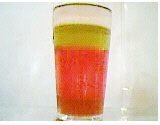


|
Liquids density
Science at Home |
||
|
Materials
|
Compounds
|
Videos: download.avi (167 KB)
Pictures: 
|
|
Procedure
1. Pour some currant in water. (the currant addition is made to make easier the visualization of the liquid phases) 2. Pour the solution of water and currant in the glass. 3. Followed, carefully, pour the olive-oil in the glass. (you can make the addition with the help of a table spoon cable) 4. Then, add the ethyl alcohol.(you can use the same procedure as previously) 5. Finally, add the honey. 6. Now you can verify that the alcohol is in the top. After the alcohol it comes the olive-oil, red colored water and, in the bottom, honey. |
||
|
Why?
Liquids that float in other liquids! When oil spils happens in sea, it floats in the surface of the water because it doesn't mixture with water and it has a lower density. In the present experiment we can observe that the water floats in a known fluid. That fluid is the honey, being the densest liquid of the group that were analyzed. The water is the second denser liquid analyzed, being heavier than the olive-oil and ethyl alcohol, and lighter than the honey. Not surprisingly, the olive-oil floats in water, having a less density than it. The olive-oil doesn't float in alcohol and, therefore, is heavier than it. In relation to the ethyl alcohol, this is the liquid that presents the smallest density of those analyzed. Picking up the same volume of each one of the analyzed liquids, the one with higher density (bottom) would have a larger amount of matter (mass) per volume unit. In contrast, the alcohol would be the reverse. |
||
No part of this website can be reproduced without previous authorization. Please inform me if there is any problem with the website. |